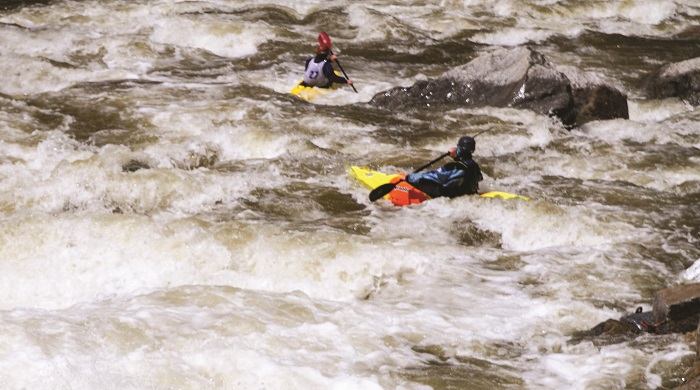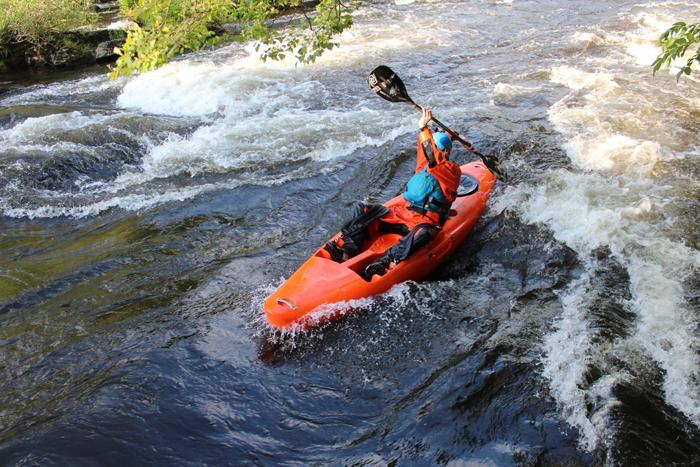In more and more paddling classes, I hear the question, “Can you run whitewater with a Sit-On-Top kayak?” In paddling, there are no absolutes. As soon as you say you can’t do this or that, someone will pop up with a saga about a friend who ran the Gauley from end to end, paddling a laundry tub. So, in this article, we’ll stick to generalities.
Yes, you can run whitewater with a Sit-On-Top, and run it well, within limits. In fact, many liveries and outfitters who service whitewater rivers and streams prefer to rent Sit-On-Tops because of their safety and ease of use. But, there are meaningful differences between Sit-On-Tops and decked boats (sit-in-side) intended for whitewater.
To begin with, you can “wear” a decked boat, tight enough so it moves with your body. Not only do you have foot pegs and a deck to wedge your knees and thighs against, but the cockpit comes up above your waist. This enables you to employ pads beside and over top of the hips to create a better lock with the boat. Spray skirts and backbands further strengthen the bond.
With a Sit-On-Top (SOT) kayak, your bond is largely created by the thigh straps. Therefore, it’s critical to ensure that you can get the best lock possible with a slight tensioning of your legs. The location of the thigh strap attachment points (usually pad eyes), the positioning of your feet, and adjustment of the thigh straps must enable you to get a good lock, with minimal chance of the straps slipping your knees at a critical juncture. Strap design can also help. Some straps are contoured to fit better around the knee area. Well-adjusted foot pegs and a backrest will help too.
The implications are that you don’t have the degree of boat control you would have with a decked boat, but you can still execute the essential J-lean and other techniques. The big difference is self-rescue. It is much more difficult to roll a SOT, especially without a waist belt (which can be a risky piece of equipment).
The SOT rescue technique can be quite easy, if not as quick as a roll. As in all cases of capsizes, immediately ensure that you are not downstream of your boat. If you are, all it takes is an obstacle to pin on, and the tremendous force of the moving water on the boat will crush or drown you.
Assuming that luck is with you, the kayak has somehow come out right side up. All you have to do is flop over the seat perpendicular to the keel, get your center of gravity over the middle of the boat, and then flip over on your butt and pivot. How? Some people simply approach the boat from the side, find two good handholds and pull themselves up and over. People who have trouble with that sometimes find it easier to envision pulling the edge of the boat down, under, and back. If you still have trouble, get a swimming start at the side of the boat, so that your body is relatively horizontal and you have momentum working for you. Whatever technique you use, practice, practice, practice. This needs to be automatic in “combat” situations.
Returning to our capsize, we now assume that the kayak has come out of the mishap upside down. The first task becomes to get it right side up. Some paddlers with some kayaks can do this by positioning themselves on one side of the boat at the midpoint, and simultaneously executing a scissors kick while doing a quick “front press” on the gunwale, flipping the boat over. I’ve also seen people push up on one gunwale while reaching under the boat and yanking the thigh strap or carry handle on the other. Some paddlers install the handles just for this reason.

If you cannot do this, you’re going to have to go up and over the kayak, grab the strap or other handhold under the other side, and fall back to the right of the boat. Putting weight on your knees helps. In fact, I’ve seen agile paddlers who could roll the boat under them, without falling back into the water. The bottom of the hull is slippery and the midships is often floating highest. So, if you can’t mount the boat from the side. Try coming from fore or aft. Once, you’ve righted the boat, use the previously detailed technique to mount it.
If you get separated from your boat and are moving with the current downstream, get on your back, facing up, with your feet downstream. Arch your back to keep your butt way up so it doesn’t catch a rock. For the same reason, keep your head back. But be alert to sideslip around obstacles and watch for throw ropes.
Most SOTs are longer and wider than modern whitewater decked boats. Their sides are usually rounded. Therefore, they cannot maneuver as quickly. Very tight and fast-moving water becomes a more dangerous proposition. Know your limits and practice your draws and ferries.
Most whitewater SINKs (sit-in-side kayaks) have the greatest floatation amidships, thanks to the rising deck and sprayskirt, with shallow, slicey ends. Few SOTs have flattened ends. Don’t count on joining in on the squirts, wheels, and mystery moves, but you’ll probably out-surf some of your SINK friends. And, you’ll be able to blast through some holes that will eat their boats.
Aside from some design advantages and disadvantages, the rules of whitewater hold the same. Know how to read the river and practice putting your boat exactly where you need it to be.

